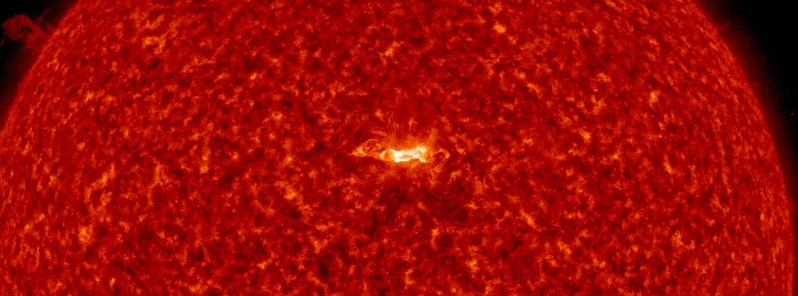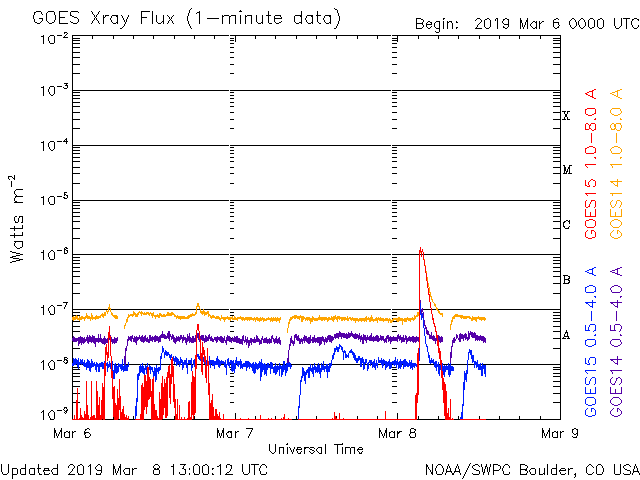C1.3 solar flare erupts from geoeffective Region 2734, CME impact expected March 11

A long-duration solar flare measuring C1.3 at its peak erupted from Region 2734 (Alpha) at 03:19 UTC on March 8, 2019. The event started at 03:07, peaked at 03:19 and ended at 03:58 UTC.
This event was associated with a Type II Radio Emission registered at 03:15 UTC with an estimated velocity of 683 km/s. Type II emissions occur in association with eruptions on the Sun and typically indicate a coronal mass ejection is associated with a flare event.

Since the region is located in geoeffective position, a coronal mass ejection (CME) impact is possible on March 11 or 12.
Associated dimming in SDO/193 imagery occurred starting near 03:11 UTC. A coronal mass ejection (CME) was first visible in LASCO C2 imagery at 04:38 UTC.
The C1.3 flare on 2019/03/08 was very eruptive. These videos of different kinds of images show large-scale coronal propagating fronts (EUV wave), coronal dimming, coronal holes and flare. Without coronagraph data, I would predict the CME will arrive at Earth on 3/11-12. pic.twitter.com/Y5tJcTeobg
— Halo CME (@halocme) March 8, 2019
Another nice look at the long duration C-class Solar Flare from Active Region 2734. Here you can see the coronal dimming occurring. H/t @TheUmno @TamithaSkov @halocme pic.twitter.com/jSRagHAZLB
— Mike (@SpaceWxMike) March 8, 2019
Solar activity is expected to continue at very low levels over the next 3 days, with a slight chance for C-class flares due to the weak flare potential from Region 2734.
Solar wind conditions are anticipated to be slightly enhanced through March 10 as several tenuous, isolated, negative polarity CH HSS undergo weak connections with the near-Earth environment. There is also the possibility of brief connections with the south polar crown.
The geomagnetic field is expected to be at quiet to unsettled levels on March 8, increasing to unsettled to isolated active intervals on March 9 with quiet to unsettled levels on March 10. This activity is due to geoeffective, negative polarity CH HSS influence.
Update:
Region 2734 (N08W17, Hax/alpha) produced a long duration C1/Sf event at 03:19 UTC, followed by a secondary C1 enhancement, which peaked shortly after at 03:36 UTC, SWPC forecasters said 00:30 UTC, March 9.
GOES-14 SXI imagery depicted the source of the bimodal X-ray signature with initial brightening in the leading portion of the region followed by brightening in the trailer portion of the region.
Associated with both events were two separate CME signatures, a western directed CME, first seen in LASCO C2 imagery at 04:28 UTC, March 8, followed by an eastern directed CME, first seen in LASCO C2 imagery at 04:38 UTC.
Analysis and modeling of the two signatures suggested most of the ejecta from the western-oriented CME was directed upstream of Earth, with enhancement from the periphery of the CME likely early on March 11.
Ejecta from the second CME was projected to pass downstream of Earth's orbit, with a chance for minor enhancement late on March 11.
The geomagnetic field is expected to be at quiet to unsettled levels on March 9 and 10 due to negative polarity CH HSS influence.
By March 11, field conditions are expected to reach G1 – Minor storm conditions due to CME arrival early in the day.
Featured image credit: NASA SDO/AIA 304

Commenting rules and guidelines
We value the thoughts and opinions of our readers and welcome healthy discussions on our website. In order to maintain a respectful and positive community, we ask that all commenters follow these rules.